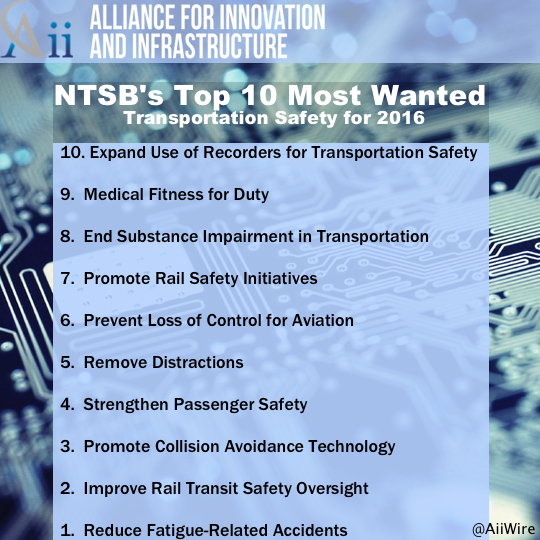A contribution by Chanil N. De Silva; Director of Policy at Nouveau Inc.
The NTSB released its annual “Most Wanted” transportation safety improvements for 2016. The list covers aviation, highway, marine, rail and pipeline networks and has been called a “roadmap from lessons learned to lives saved”.
This year’s list highlights the important role innovative technology in preventing accidents and reducing the severity of injuries from accidents.
1. Reduce fatigue related accidents
According to the NTSB 20 percent of all major investigations between 2001 and 2012 were attributed to human fatigue. The NTSB calls for a multi-pronged approach which includes research, education and training, hours-of-service regulations, and on- and off-duty scheduling policies combined with treatment of sleep disorders, and the implementation of monitoring and alerting technology.
2. Improve rail transit oversight
Rail infrastructure must be constantly monitored and maintained in order to identify potential safety threats and fix them before it leads to tragedy. The NTSB has found that certain oversight authorities lack the ability and resources to carry out necessary oversight and carry out required corrective action efficiently. Therefore improvements in oversight are essential.
3. Promote availability of collision avoidance technologies in highway vehicles
Collision avoidance systems drastically reduce the severity and frequency of highway accidents by countering human error. Currently available collision avoidance technology for commercial and passenger vehicles should be made standards in all new vehicles.
4. Strengthen occupant protection
The NTSB supports primary enforcement of restraint systems for all seating positions in passenger vehicles and age appropriate restraint systems for children. In terms of rail, improved car designs to increase safety, preserve survival space and enhance evacuation systems are required.
5. Disconnect from deadly distractions
Although technology can help increase safety, it can also decrease it. The NTSB has found that Personal Electronic Devices contributes to accidents across all modes of transportation. The recommendations include strict rules to minimize distractions such as mobile phones and handheld devices, even in hands free mode while operating a vehicle.
6. Prevent loss of control in flight in general aviation
Though aviation related incidents have seen a downward trend, 47 percent of fatal fixed-wing aviation accidents in the U.S. between 2008 and 2014 have been attributed to pilots losing control of the aircraft. The NTSB calls for increased pilot education, flight currency, self-assessment, vigilant situational awareness in the cockpit and supportive technologies to help prevent loss of control.
7. Promote the completion of rail safety initiatives
Positive Train Control (PTC) has been proven to save lives and prevent collisions and derailments and although it was mandated by congress, the deadline for implementation was extended, putting lives at risk. The NTSB calls for the swift implementation of Positive Train Control technology on trains together with revised standards for DOT 111 tank cars that transport hazardous material in order to increase rail safety.
8. End substance impairments in transportation
Within the last 15 years, one third of highway deaths involved an alcohol-impaired driver. However, today, impairments include those caused by drugs, including prescribed and over the counter medication. NTSB calls for more research into their effects combined with expanded regulation to cover known “problem” drugs.
9. Require medical fitness for duty
The prevalence of untreated or undiagnosed medical conditions in safety critical personnel such as public vehicle operators can put thousands of lives in danger. Currently, no system of verification exists to ensure that these conditions are accounted for. The NTSB therefore recommends a medical certification system for such personnel to ensure they are medical fit to take up their duties.
10. Expand use of recording to enhance transportation safety
Finding out what led to an accident can be one of the best forms of tools to prevent them on the future. Recording devices in the forms of inward facing cameras and audio equipment is key to this. However, certain vehicles including varieties of aircrafts, trains, ferries and buses are still not equipped with these. In order to learn from mistakes and prevent the same occurring in the future such technology should be made mandatory across all necessary modes of transportation.
In a world where technology is heavily integrated into our daily existence and is used across a variety of industries, it only makes sense that it is also used to improve transportation safety, thereby reducing damage to infrastructure and saving countless lives.
Many of the technologies and best practices recommended in NTSB’s “Most Wanted” list are ready, available, and easily implemented. However, implementing these critical safety updates will require cooperation from stakeholders across the transportation landscape and at least some degree of government participation, oversight, and encouragement.
